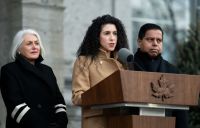Government Aims to Use Immigration Policy to Support Economic Growth
Canada is weighing steps to settle refugees in parts of the country with low unemployment levels, signaling the government’s effort to use immigration policy to support economic growth—without alienating voters.
Canada has one of the highest per capita immigration rates in the Group of 20 industrial and developing nations, and just over half of immigrants and nearly half of refugees to Canada settle in Ontario, the country’s largest province, which has a higher unemployment rate than faster-growing Alberta, which attracts a much smaller share of newcomers.
Refugees deemed by immigration officials to have been forced to flee their homeland are accepted into Canada as asylum seekers under a United Nations convention to which Canada and the U.S. are both signatories. Unlike most other classes of would-be immigrants to Canada, who are rated on a point system to evaluate their ability to find work here, refugees don’t face any labor-force tests.
Refugees could help meet demand for unskilled labor by settling in the resource-rich Alberta, and help to avoid concentrations of unemployed immigrants in central Canada, Minister of Employment Jason Kenney said in an interview.
“The immigration department is now looking at how we might locate more [refugees] in Alberta as opposed to spreading them all across the country,“ he said. “Why would we not locate government-resettled refugees in regions with tight labor markets and more employment opportunities?”
Such a program would build on a series of immigration moves aimed at supporting economic growth while easing concerns about the country’s ability to absorb more immigrants, especially in the central and eastern provinces, where unemployment rates are higher. This month, the government announced a pilot program targeting skilled immigrants who invest at least two million Canadian dollars (US$1.72 million) for 15 years into a venture-capital fund, but which is initially limited to about 50 investors and their families a year.
Prime Minister Stephen Harper ’s Conservative government has sought to balance the burgeoning flow of immigrants—who have become a core voting bloc for his party—with concerns that newcomers might take jobs away from lifelong Canadians or reduce household income by checking wage inflation. Canada, with a population of 35.7 million, accepted 258,953 immigrants in 2013, according to government data, of which 9.3%, or 24,047, were refugees.
That balancing act led Mr. Harper’s government to curtail a temporary foreign worker program this year in response to complaints that employers, including some McDonald’s Canada franchises, sought to hold wages down by tapping overseas labor. The temporary worker category quietly had become one of the main immigrant routes into the country, ballooning to 338,000 as of 2012, up from just under 250,000 in 2008, according to the most recent government data available.
The service industry in Alberta has grown to rely on foreign workers, who come to the country on special visas to do specific jobs, and limiting their entry angered business groups and politicians. But Alberta has attracted a small share of other categories of immigrants, and only 11% of refugees, or 2,751 people. The unemployment rate in Ontario is higher, at 7%, than Alberta’s 4.5% level.
Alberta grew faster than the rest of the Canadian economy as a whole in 2013 for a fourth consecutive year, the federal government reported in November. Real gross domestic product grew 3.8% last year, compared with 1.3% in Ontario and 1% in Quebec, and a national average of 2%, according to Statistics Canada.
The Canadian government has also faced criticism over its handling of refugees over a series of 2012 measures, which sought to close loopholes and crack down on suspected immigration fraud. A report published last year by Harvard University’s law school criticized those changes to Canada’s immigration policy, calling it an attempt to initiate a “systematic closing” of the country’s borders to asylum seekers.
The U.S. is the world’s top country in terms of offering resettlement of refugees, although states such as Canada, Australia and the Nordic countries provide a sizable number of places annually, according to the United Nations Human Rights Council.
Requiring refugees to move to certain parts of the country could be viewed as a controversial measure, and Mr. Kenney, who served five years as immigration minister until July 2013, said refugees wouldn’t be prevented from moving again once settled. But municipalities like Grand Prairie in northern Alberta offer more job opportunities than eastern cities like Montreal where immigrant enclaves have high unemployment rates, he said.
Mr. Kenney defended the move to limit permits for short-term foreign workers and said the government would consider exemptions only for extremely tight labor markets such as the British Columbian towns of Whistler, a mountain ski resort, and Kitimat, an industrial hub on the remote northwest Pacific coast.
“We will not allow large-scale admission of low-paid people into entry-level jobs that end up freezing those wage rates and discouraging Canadians from going into [those] jobs,” he said, adding that a recent drop in global oil prices may result in less demand for low-skilled labor in Alberta.
The employment minister also said economic growth and support from immigrants as a voting bloc are key to the Harper government’s hopes of extending its hold on power.
“Who can you trust to ensure economic growth and stability in Canada? If that’s the question voters ask themselves in October of next year, then we’ll be re-elected—whether they’re new Canadians or otherwise,” Mr. Kenney said.
The Wall Street Journal









